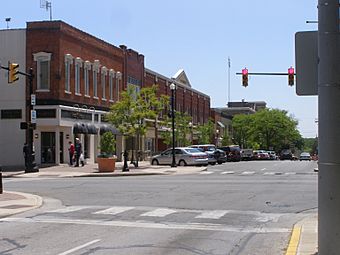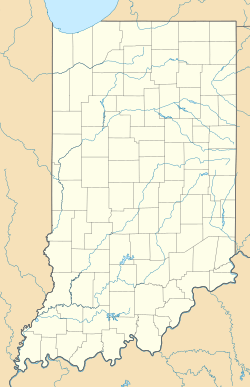Valparaiso Downtown Commercial District facts for kids
Quick facts for kids |
|
|
Valparaiso Downtown Commercial District
|
|

Franklin east of Courthouse
|
|
| Location | Roughly bounded by Jefferson, Morgan, Indiana, and Napoleon, Valparaiso, Indiana |
|---|---|
| Area | 14 acres (5.7 ha) |
| Architect | Multiple |
| Architectural style | Italianate, Commercial Style |
| NRHP reference No. | 90000327 |
| Added to NRHP | February 23, 1990 |
The Valparaiso Downtown Commercial District is a special area in Valparaiso, Indiana. It is a busy place where government, shops, and businesses all come together. People also live here, and there are many restaurants. Even with many changes over the years, the downtown area has kept its unique look. It still has beautiful buildings from the late 1800s and early 1900s. You can find many small, interesting shops, shady sidewalks, and a friendly atmosphere. The heart of this district is the Porter County Courthouse. The district covers 14 blocks around the courthouse square. It is bordered by Jefferson Street to the north, Morgan Street to the east, Monroe Street to the south, and Napoleon Street to the west.
Contents
How Valparaiso's Downtown Began
The town of Portersville was first planned in 1836. The very next year, its name was changed to Valparaiso. This new name honored Commodore David Porter. It was named after his last battle near the port of Valparaiso in Chile. The county itself was also named after Commodore Porter. The first buildings in the town were built near the Morgan Street bridge. The town did not start to grow much until 1850. This was when the first railroad line was built through the area.
The Story of the Courthouse
The first courthouse was finished in 1837. It was a simple building made of wood. This building was replaced in 1852 with a new one. Then, in 1885, a third courthouse was built using strong limestone. The courthouse you see today is that 1885 building. It was fixed up after a fire in 1934. The fire sadly destroyed its tall clock tower.
Early Public Buildings
The county jail was located on Mechanic Street, which is now Indiana Street. The first jail was a log cabin. In 1871, a modern limestone building replaced it. This new jail was connected to the Sheriff’s house, which had been built 11 years earlier.
Public shows and events were held at the Grand Opera House. It opened in 1874. This building was first known as the Fiske Opera House. It was the first public place in Valparaiso where large groups could gather. The first floor had shops, and the second floor could hold up to 700 people. Later, in 1893, the Memorial Hall was built. It honored soldiers who fought in the Civil War. This larger hall could hold an audience of 1,000 people.
Important Buildings in the District
Many buildings in the Valparaiso Downtown Commercial District are important. They help make the area a "Historic District." This means they have special historical or architectural value.
Buildings on West Lincolnway
- 170 West Lincolnway: Valparaiso Post Office
- This building was designed in a style called Neoclassical. It opened in 1919 as the U.S. Post Office. The building looks grand because it is set back from the sidewalk. It has stairs leading up to the entrance. The city bought this building in 1987. They fixed it up to use as the City Hall.
- 162 West Lincolnway: Grand Opera House
- This building, also known as the Odd Fellows Building, was built between 1871 and 1874. It is in the Italianate style. It was the first place in Valparaiso for plays and performances. The upper floor had an auditorium that could hold 700 people. Before the Memorial Opera House was built, this was the only theater in town.
- 150 West Lincolnway: Elks Temple
- This building was built in 1924 in the Colonial Revival style. It was built after the previous building on this spot burned down. The Elks, a community group, rebuilt their home here. It has a fancy entrance on Lafayette Street for the upper floors. The building was updated in 1988. The Elks have since moved from this building.
- 70, 68, 66-64 West Lincolnway: Commercial Buildings
- These buildings were built around 1880. They are also in the Italianate style.
- 62 and 60 West Lincolnway: Horn's Block
- These buildings were built in 1921. They have a practical, 20th-century design.
- 58 West Lincolnway: Post Tribune Building
- This building was built around 1870. It has a practical, 19th-century design.
Buildings on East Lincolnway
- 101 East Lincolnway: Farmer's State Bank
- This bank building was built in 1927 in the Neoclassical style. It was designed by Frederic Beck. The building uses Indiana Limestone and sandstone. The main entrance has a large arched doorway. It also has some Art Deco style details. It is still a bank today.
Buildings on Courthouse Square
- Porter County Courthouse
- This important building was built in 1885. It has a mix of Second Empire and Neoclassical styles. It was repaired in 1934 after a fire.
Buildings on West Indiana Street
- 14 West Indiana Street: First State Bank of Valparaiso
- This bank was built in 1903 in the Neoclassical style. This style was popular for banks because it suggested wisdom and safety. The building uses Indiana Limestone. It has tall pillars that look like the ones on the courthouse across the street. This building has changed owners many times but remains a bank.
- 102 West Indiana Street: Sheriff's Residence
- This house was built in 1860 in the Italianate style. It was where the Sheriff lived. Today, it is part of the Porter County Museum.
- Porter County Jail
- The jail was built in 1871. It is next to the Sheriff's Residence. It is also part of the Porter County Museum today.
- 104 West Indiana Street: Memorial Hall
- This building was built in 1893 in the Romanesque Revival style. It was built to honor Civil War veterans.
Images for kids











